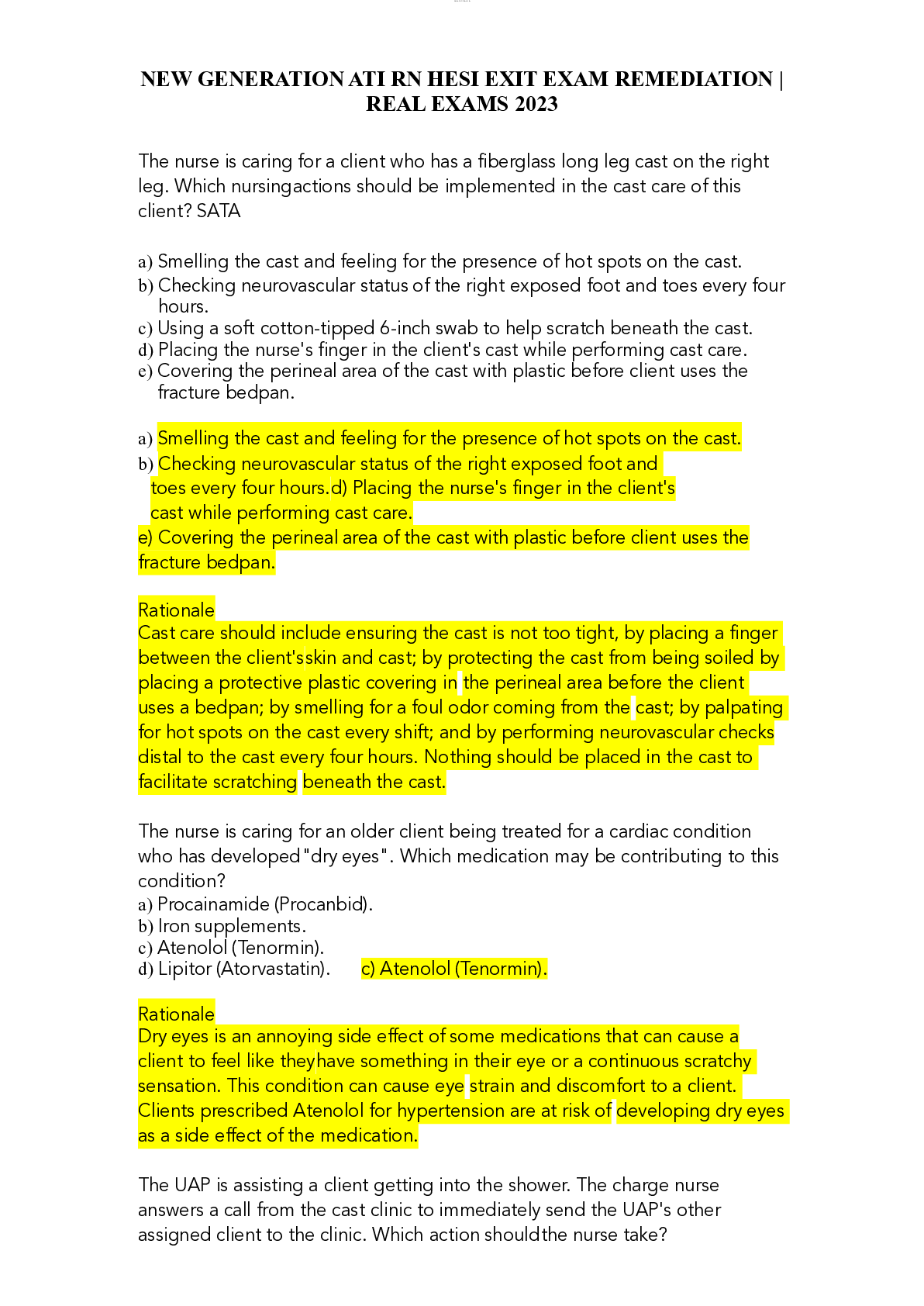Pharmacology > EXAM PROCTORED > ATI Remediation Pharmacology Final {2020} | ATI PROCTORED EXAM REMEDIATION | PHARMACOLOGY II (All)
ATI Remediation Pharmacology Final {2020} | ATI PROCTORED EXAM REMEDIATION | PHARMACOLOGY II
Document Content and Description Below
ATI Remediation Pharmacology Final {2020} ATI PROCTORED EXAM REMEDIATION PHARMACOLOGY II 1. SAFETY AND INFECTION CONTROL a. ACCIDENT/ERROR/INJURY PREVENTION i. SAFE MEDICATION ADMINISTRAT... ION AND ERROR REDUCTION: ADMINISTERING PHENYTOIN 1. Undesirable interaction is giving omeprazole, a proton pump inhibitor, concurrently with phenytoin, an anticonvulsant. This can increase the serum level of phenytoin. Obtain a complete medication history, and be knowledgeable of clinically significant interactions. Be aware that medications can also interact beneficially or harmfully with food and with herbal and dietary supplements ii. ANTIBIOTICS AFFECTING THE BACTERIAL CELL WALL: PRIORITY FINDING AFTER A PENICILLIN INJECTION 1. Instruct clients to take penicillin V, amoxicillin, and amoxicillin‑clavulanate with meals. Tell them to take all others with 8 oz of water 1 hr before or 2 hr after meals. Instruct clients to report any signs of an allergic response such as dyspnea, a skin rash, itching, and hives. Give IM injections cautiously to avoid injecting into a nerve or an artery. Advise clients to complete the entire course of therapy, even if symptoms resolve. Advise client to use an additional contraceptive method when taking penicillin’s. iii. REPORTING OF INCIDENT/EVENT/IRREGULAR OCCURRENCE/VARIANCE 1. SAFE MEDICATION ADMINISTRATION AND ERROR REDUCTION: PRIORITY ACTION FOR INCORRECT MEDICATION DOSAGE a. Use a unit‑dose system to decrease errors. If not available, calculate the correct medication dose. Check a drug reference to ensure the dose is within the usual range. When performing medication calculations or conversions, have another qualified nurse check the calculated dose. Prepare medication dosages using standard measurement devices, such as graduated cups or syringes. Some medication dosages require a second verifier or witness, such as some cytotoxic medications. Automated medication dispensing systems use a machine to control the dispensing of medications. 2. SAFE MEDICATION ADMINISTRATION AND ERROR REDUCTION: INDENTIFY A SITUATION REQUIRING AN INCIDENT REPORT a. Report all errors, and implement corrective measures immediately. Complete an incident report within the time frame the facility specifies, usually 24 hr. This report should include ■Client’s identification ■Name and dose of the medication ■Time and place of the incident ■Accurate and objective account of the event ■Who you notified ■What actions you took ■Your signature (or that of the person who completed the report) Do not reference or include this report in the client’s medical record. Medication errors relate to systems, procedures, product design, or practice patterns. Report all errors to help the facility’s risk managers determine how errors occur and what changes to make to avoid similar errors in the future. 3. MISCELLANEOUS CENTRAL NERVOUS SYSTEM MEDICATIONS: TREATMENT FOR MUSCARINIC POISONING a. Extreme muscarinic stimulation can result in increased gastric acid secretion, abdominal cramps, diarrhea, sweating, tearing, urinary urgency, bradycardia and hypotension; bronchoconstriction b. NURSING CONSIDERATIONS ●Instruct clients to report adverse effects if they occur. Monitor for bradycardia and hypotension. ●Administer on an empty stomach to reduce effects. 2. PSYCHOSOCIAL INTEGRITY a. CHEMICAL AND OTHER DEPENDENCIES/SUBSTANCE USE DISORDER i. SUBSTANCE USE DISORDERS: TREATMENT FOR COCAINE TOXICITY 1. 3. PHARMACOLOGICAL AND PARENTERAL THERAPIES i. ADVERSE EFFECTS/CONTRAINDICATIONS/SIDE EFFECTS/INTERACTIONS 1. MYCOBACTERIAL, FUNGAL, AND PARASITIC INFECTIONS: INTERPRETING SIDE EFFECTS OF RIFAMPIN a. Rifampin accelerates metabolism of warfarin, oral contraceptives, protease inhibitors, and non‑nucleoside reverse transcriptase inhibitors (NNRTIs) for HIV, resulting in diminished effectiveness. b. NURSING CONSIDERATIONS ● Increased dosages of HIV medications are often necessary. ● Monitor PT and INR. ● Advise clients to use a non‑hormonal form of contraception. 2. CHRONIC NEUROLOGIC DISORDERS: ADVERSE EFFECTS OF PHENYTOIN a. CNS effects ●Nystagmus, sedation, ataxia, double vision, cognitiveimpairment b. NURSING CONSIDERATIONS: Monitor for manifestations of CNS effects, and notify the provider if they occur. Gingival hyperplasia ●Softening and overgrowth of gum tissue, tenderness, and bleeding gums NURSING CONSIDERATIONS: Advise clients to maintain good oral hygiene (dental flossing, massaging gums). Folic acid supplements can decrease the occurrence. Skin rash c. NURSING CONSIDERATIONS: Stop medication if rashdevelops.Cardiovascular effects: dysrhythmias, hypotensionNURSING CONSIDERATIONS ●Administer at slow IV rate (no faster than 50mg/min) and in dilute solution to prevent adverse cardiovascular effects. ●Avoid administering to a client who has sinus bradycardia, sinoatrial block, or Stokes‑Adams syndrome. Endocrine and other effects ●Coarsening of facial features, hirsutism, and interference with vitamin D metabolism d. NURSING CONSIDERATIONS- Instruct the client to report changes.-Encourage the client to consume adequate amounts of calcium and vitamin D. Interference with vitamin K‑dependent clotting factors causing bleeding in newborns e. NURSING CONSIDERATIONS: Administer prophylactic vitamin K to the mother for 1month before the infant is delivered. 3. MISCELLANEOUS PAIN MEDICATIONS: ADVERSE EFFECTS OF ERGOTAMINE a. Gastrointestinal discomfort Such as nausea and vomiting b. NURSING CONSIDERATIONS: Administer an antiemetic, such as metoclopramide. Acute or chronic overdose (ergotism) c. ●Muscle pain, paresthesia’s in fingers and toes; peripheral ischemia NURSING CONSIDERATIONS: Stop medication, and immediately notify the provider if symptoms occur. d. Physical dependence NURSING CONSIDERATIONS ●Advise clients not to exceed the prescribed dose. ●Medication should not be taken daily on a long‑term basis. ●Inform clients regarding symptoms of withdrawal (headache, nausea, vomiting, restlessness). ●Notify the provider if symptoms occur. e. Fetal harm or abortion NURSING CONSIDERATIONS ●Avoid using this medication during pregnancy. ●Advise clients to use additional contraception while using the medication. 4. MEDICATIONS AFFECTING BLOOD PRESSURE: ADVERSE EFFECTS OF ABRUPT PROPRANOLO - - - - - - - - - - - - - - - - - - - - - - - - - - - - - - - - - - - - 8. ANTIBIOTICS AFFECTING PROTEIN SYNTHESIS: UNDERSTANDING TEACHING ABOUT TETRACYCLINE a. Tetracyclines are Pregnancy Risk Category D. b. Taking tetracyclines after the fourth month of pregnancy can stain the deciduous teeth, but they do not affect permanent teeth. They do, however, stain the permanent teeth of children between the ages of 4months and 8 years who take them. c. Use cautiously with liver and kidney disease. Doxycycline and minocycline are generally safe for clients who have kidney disease, because the liver, not the kidneys, eliminates these two tetracyclines. d. Interaction with milk products, calcium and iron supplements, laxatives containing magnesium, and antacids causes formation of nonabsorbable chelates, thus reducing the absorption of tetracyclines 9. ANTIBIOTICS AFFECTING THE BACTERIAL CELL WALL PROPER INJECTION TECHNIQUE a. It is important to administer nafcillin IM into a deep muscle mass, such as the ventrogluteal site. b. it is important to ask the client about an allergy to penicillin or other antibiotics before administering nafcillin. An allergy to another penicillin or to a cephalosporin is a contraindication for administering nafcillin. c. When administering a penicillin or other antibiotic parenterally, it is important to monitor the client for 30 min for an allergic reaction. 10. MEDICATIONS AFFECTING BLOOD PRESSURE: CLIENT EDUCATION FOR ADRENERGIC BETA BLOCKERS a. Administer ACE inhibitors orally except enalaprilat, which is the only ACE inhibitor for IV use. b. Advise clients that the medication is prescribed as a single formulation or in combination with hydrochlorothiazide (a thiazide diuretic). c. Advise clients that blood pressure is monitored after the first dose for at least 2 hr to detect hypotension. d. Instruct clients to take captopril and moexipril at least 1hr before meals. Other ACE inhibitors are taken with or without food. e. Advise clients to notify the provider if cough, rash, dysgeusia (altered taste), or indications of infection occur. f. Advise client to rise slowly from sitting. g. Advise client to avoid activities that require alertness until effects are known. h. Advise clients to report if pregnancy is suspected. 11. PEPTIC ULCER DISEASE: ANTACID THERAPY a. Clients taking tablets should be instructed to chew the tablets thoroughly and then drink at least 8 oz of water or milk. b. Teach clients to shake liquid formulations to ensure even dispersion of the medication. c. Compliance is difficult for clients due to the frequency of administration. Medication can be administered seven times a day: 1 hr and 3 hr after meals, and again at bedtime. Encourage compliance by reinforcing the intended effect of the antacid (such as relief of pain, healing of ulcer). d. Teach clients to take all medications at least 1 hr before or after taking an antacid 12. MEDICATIONS AFFECTING URINARY OUTPUT: MONITORING FOR LABORATORY VALUES a. Monitor cardiac status and potassium levels. b. Report a decrease in potassium level (K+ less than 3.5mEq/L). c. Teach clients to consume high‑potassium foods (e.g.,bananas, potatoes, dried fruits, nuts, spinach, and citrusfruit). d. Teach clients manifestations of hypokalemia, such as nausea, vomiting, fatigue, leg cramps, and general weakness. v. PARENTERAL/INTRAVENOUS THERAPIES 1. DOSAGE CALCULATION: CALCULATING IV FLOW RATE a. Quantity × Conversion (Have) × Volume 1ml Conversion (Desired) Time vi. PHARMACOLOGICAL PAIN MANAGEMENT 1. OPIOD AGOIST AND ANTAGONISTS: FINDINGS TO REPORT TO THE PROVIDER a. Obtain baseline vital signs. If the respiratory rate is less than 12/min, withhold the medication and notify the provider. b. Have naloxone and resuscitation equipment available. c. Assess clients for opioid dependence prior to administration. Agonist‑antagonists can trigger withdrawal symptoms. ●Warn clients not to increase dosage without consulting the provider. ●Advise clients to use caution when getting out of bed or standing. Clients should not operate heavy machinery or drive until CNS effects are known. ●Warn clients not to increase dosage without consulting the provider. [Show More]
Last updated: 2 years ago
Preview 1 out of 16 pages

Buy this document to get the full access instantly
Instant Download Access after purchase
Buy NowInstant download
We Accept:

Reviews( 0 )
$10.00
Can't find what you want? Try our AI powered Search
Document information
Connected school, study & course
About the document
Uploaded On
Feb 06, 2021
Number of pages
16
Written in
Additional information
This document has been written for:
Uploaded
Feb 06, 2021
Downloads
0
Views
178


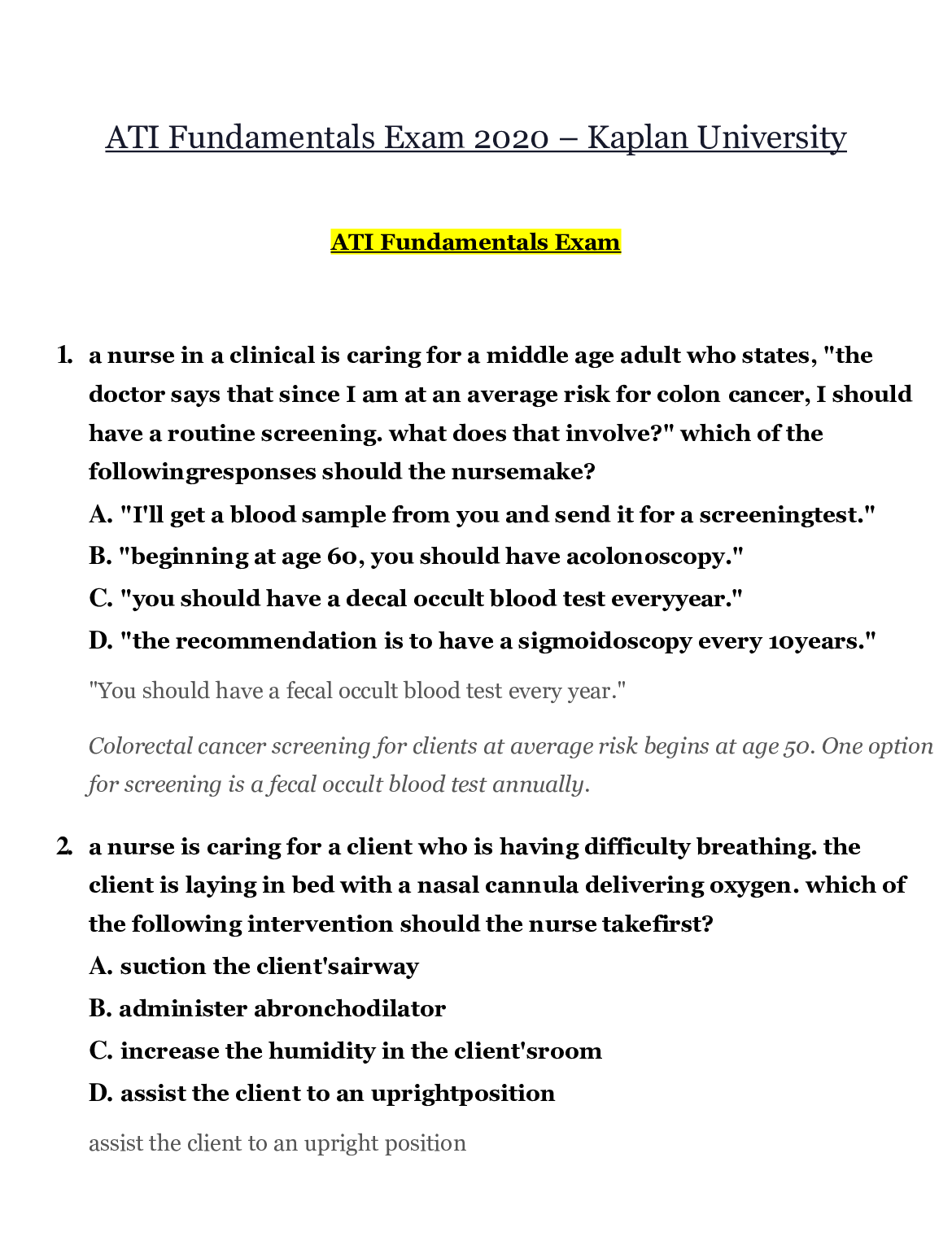
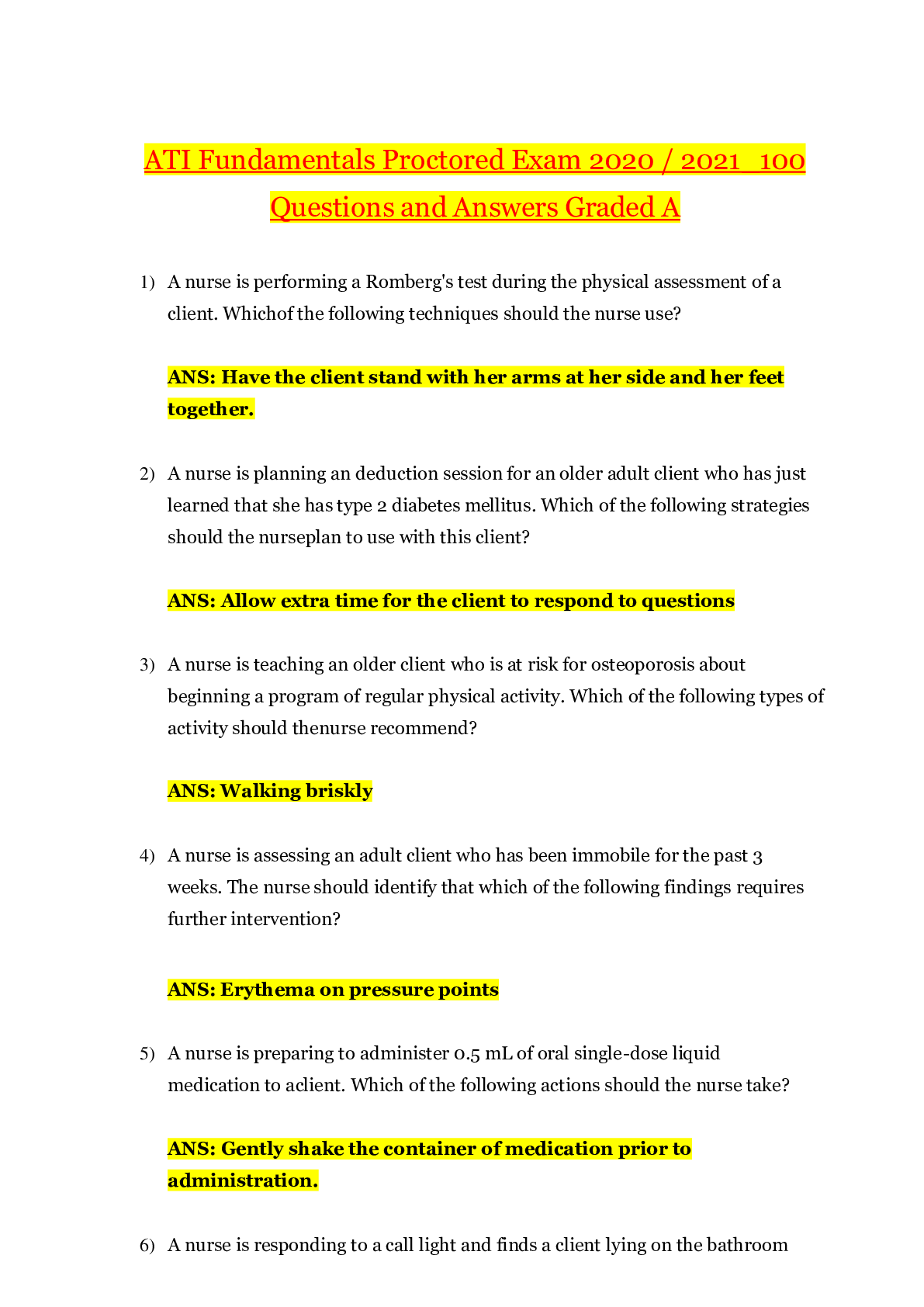



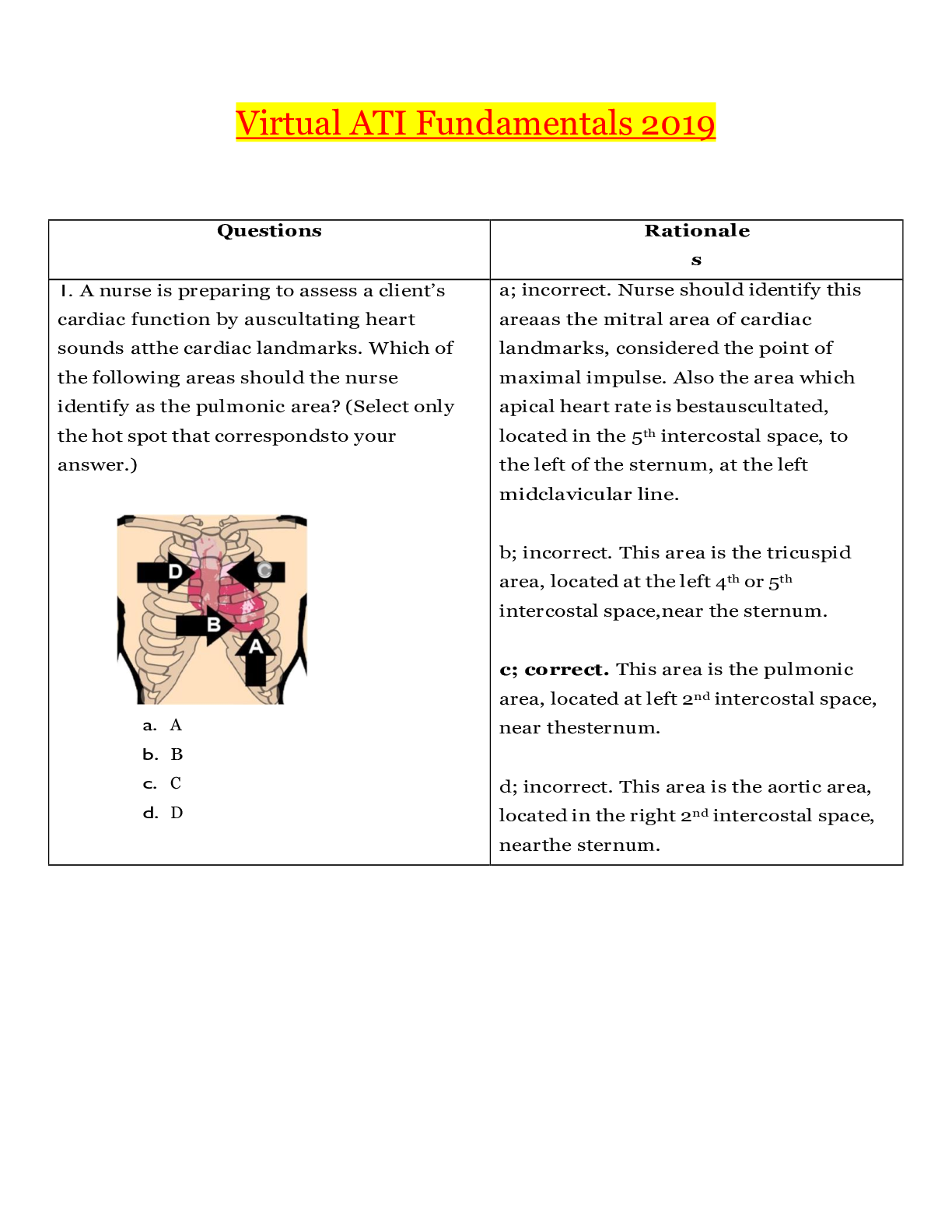






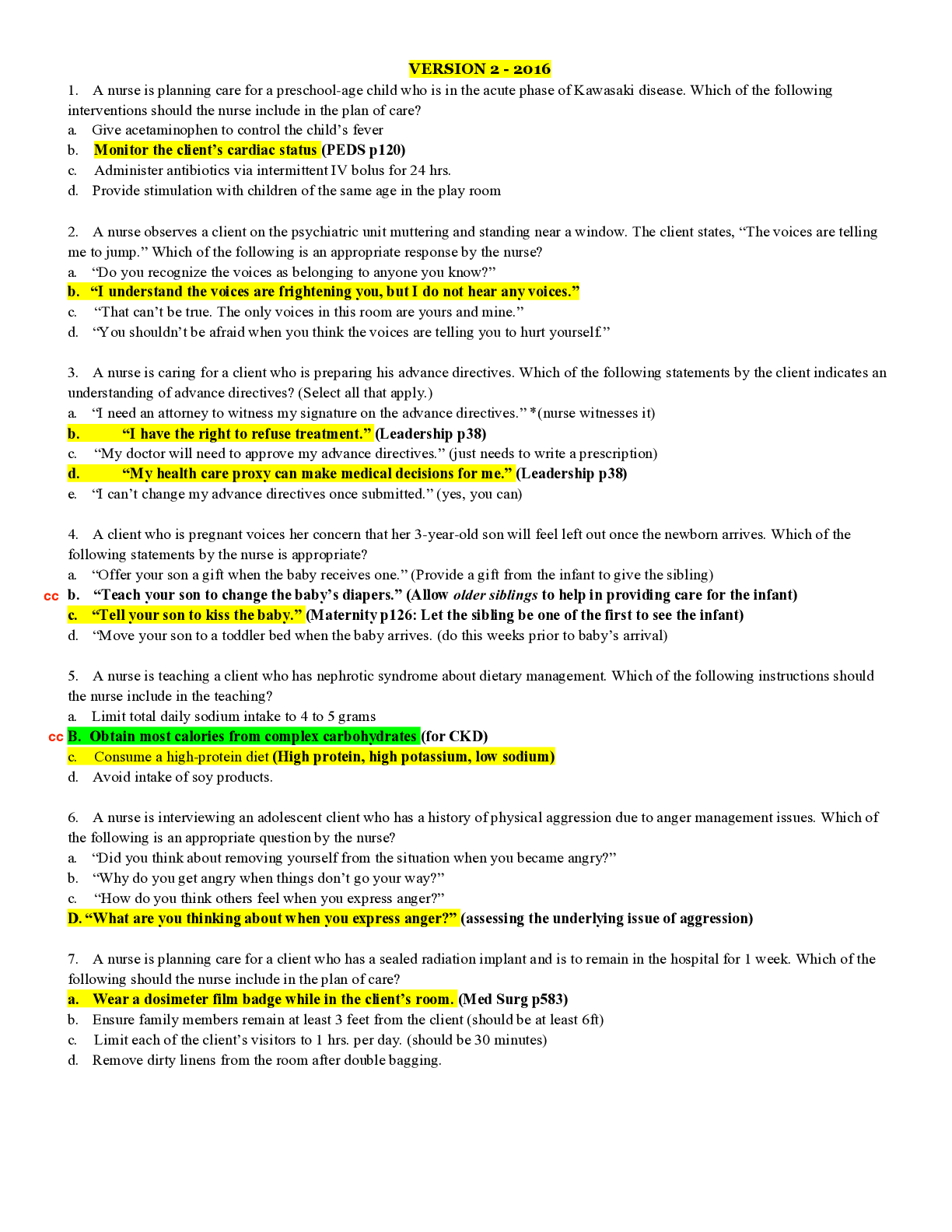

.png)
.png)

